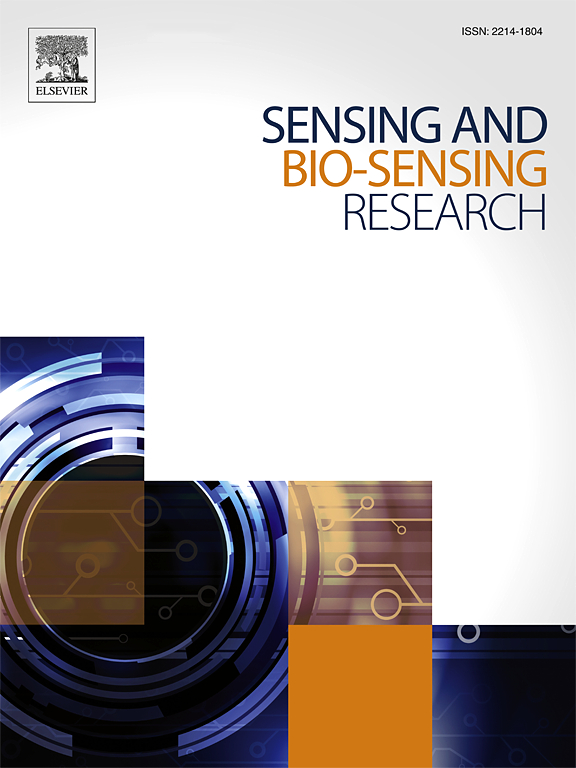Development of highly selective and sensitive electrochemical sensor for trace level determination of Cu2+ ions in different biological and Persian Gulf Algae samples
IF 5.4
Q1 CHEMISTRY, ANALYTICAL
引用次数: 0
Abstract
Herein, a novel electrochemical sensor using carbon paste electrode (CPE) modified with synthetic Schiff base 4,4′-(2,2-dimethylpropane-1,3,diyl)-bis(azan-1-yldene)dipent-2-en-2-ol(DMPDO) and MWCNTs (DMPDO-MWCNT-CPE) was fabricated for determination of Cu2+ ions in different samples. The modified CPE electrode was fully characterized with SEM., cyclic voltammetry, differential pulse voltammetry, spectrophotometric analysis and experimental conditions was thoroughly studied. The electrochemical result reveals the DMPDO-MWCNT-CPE electrode exhibits excellent electrochemical performance respect to bare CPE and other construction toward Cu2+ ions. The fabricated nano-electrochemical sensor in 0.1 acetate buffer solution (pH 5), 12 % w of Schiff base and KCl electrolyte (0.1 mol L−1) showed linear dynamic ranges 0.050–300.0 μM with detection limits (LODs) of 0.008 μ mol L−1 and limit of quantitation of 0.10 μ mol L−1. Also, with respect to other fabricated structures, it shows a wider dynamic range and lower LOD and LOQ values. Besides, the Cu2+ sensor showed strong selectivity compared to other metal ion (e.g., Al3+, Zn2+, K+, Mn2+, Ag+, Na+, Fe2+, Mn2+), high stability and excellent repeatability. The fabricated sensor was applied for to detect Cu2+ ions in some biological, wastewater and Persian Gulf algae samples. The results found with this method were comparable with those obtained with Flame atomic absorption spectrometry.
高选择性、高灵敏度电化学传感器在不同生物和波斯湾藻类样品中痕量Cu2+的研制
本文采用合成希夫碱4,4′-(2,2-二甲基丙烷-1,3,二基)-双(氮杂-1-基)二萜-2-烯-2-醇(DMPDO)和MWCNTs (DMPDO- mwcnt -CPE)修饰的碳糊电极(CPE)制备了一种新型电化学传感器,用于测定不同样品中的Cu2+离子。用SEM对改性后的CPE电极进行了全面表征。对循环伏安法、差分脉冲伏安法、分光光度法分析及实验条件进行了深入的研究。电化学结果表明,DMPDO-MWCNT-CPE电极在裸CPE和其他结构上对Cu2+离子表现出优异的电化学性能。所制备的纳米电化学传感器在0.1醋酸缓冲液(pH 5)、12%希夫碱和KCl电解液(0.1 mol L−1)中的线性动态范围为0.050 ~ 300.0 μ m,检出限(lod)为0.008 μ mol L−1,定量限为0.10 μ mol L−1。此外,相对于其他制造结构,它表现出更宽的动态范围和更低的LOD和LOQ值。此外,与其他金属离子(Al3+、Zn2+、K+、Mn2+、Ag+、Na+、Fe2+、Mn2+)相比,Cu2+传感器具有较强的选择性,稳定性高,重复性好。将该传感器应用于生物、废水和波斯湾藻类样品中的Cu2+离子检测。该方法与火焰原子吸收光谱法的测定结果基本一致。
本文章由计算机程序翻译,如有差异,请以英文原文为准。
求助全文
约1分钟内获得全文
求助全文
来源期刊

Sensing and Bio-Sensing Research
Engineering-Electrical and Electronic Engineering
CiteScore
10.70
自引率
3.80%
发文量
68
审稿时长
87 days
期刊介绍:
Sensing and Bio-Sensing Research is an open access journal dedicated to the research, design, development, and application of bio-sensing and sensing technologies. The editors will accept research papers, reviews, field trials, and validation studies that are of significant relevance. These submissions should describe new concepts, enhance understanding of the field, or offer insights into the practical application, manufacturing, and commercialization of bio-sensing and sensing technologies.
The journal covers a wide range of topics, including sensing principles and mechanisms, new materials development for transducers and recognition components, fabrication technology, and various types of sensors such as optical, electrochemical, mass-sensitive, gas, biosensors, and more. It also includes environmental, process control, and biomedical applications, signal processing, chemometrics, optoelectronic, mechanical, thermal, and magnetic sensors, as well as interface electronics. Additionally, it covers sensor systems and applications, µTAS (Micro Total Analysis Systems), development of solid-state devices for transducing physical signals, and analytical devices incorporating biological materials.
 求助内容:
求助内容: 应助结果提醒方式:
应助结果提醒方式:


